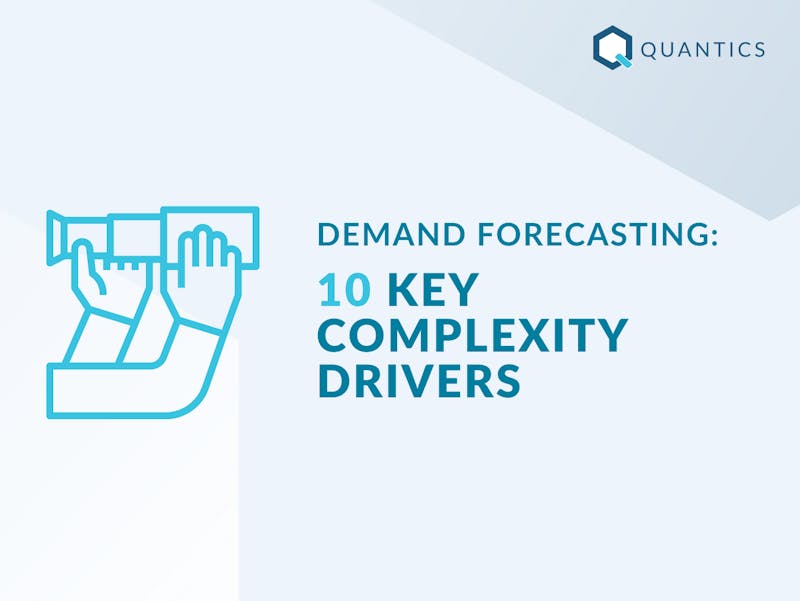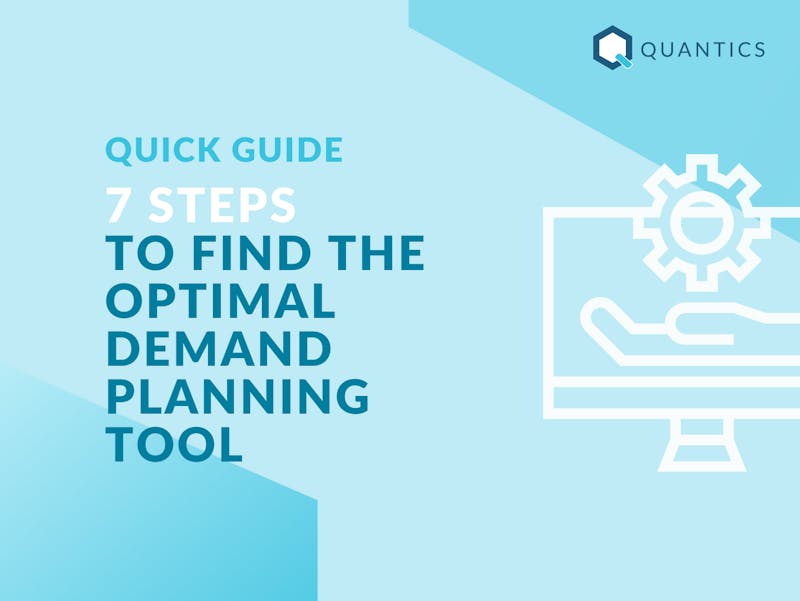Mastering Rolling Forecasts: Advanced Strategies for Manufacturers
In the dynamic landscape of manufacturing, mastering rolling forecasts has become critical for achieving operational excellence and staying ahead of market dynamics.
Rolling forecasts are a very helpful tool to enhance agility and responsiveness in a rapidly evolving business environment. Unlike a static forecast that is conducted once, the rolling forecasts are updated on a continuous basis (e.g. weekly rolling), allowing manufacturers to adapt their forecasts and plans based on the latest available information. This dynamic approach enables manufacturers to more accurately predict changes in market conditions, customer demand, and supply chain dynamics, empowering them to make proactive decisions and stay ahead of the competition.
In this article, we explore advanced forecasting & planning strategies that can be utilized in combination with rolling forecasts, providing manufacturers with actionable insights and best practices for optimizing their forecasting and planning processes also in fast paced and volatile environment. From scenario planning to agile supply chain orchestration and integrated business planning, we delve into the key components of successful rolling forecast strategies and highlight the benefits they offer to manufacturers in today's competitive landscape.
1. Scenario Planning
Rolling forecasts enable businesses to adjust plans based on the latest information, allowing manufacturers to quickly incorporate deviations. However, adjusting business operations can take considerable time. Therefore, preparing for different future scenarios from the outset can significantly enhance the benefits of rolling forecasts.
Creating Hypothetical Scenarios:
In scenario planning, manufacturers engage in the creation of hypothetical situations that reflect potential future states of the market, supply chain, and economy. These scenarios encompass a wide range of variables, including market fluctuations, supply chain disruptions, economic changes, geopolitical events, and regulatory shifts. By simulating diverse scenarios, manufacturers gain valuable insights into potential outcomes and devise proactive strategies to address them. For instance, they may analyze scenarios such as fluctuating consumer demand, disruptions in raw material availability due to geopolitical tensions, or changes in regulatory policies affecting their operations.
Manufacturers can leverage advanced data analytics and predictive modeling techniques to develop these scenarios. By incorporating historical data, market trends, and expert insights, they can create realistic scenarios that capture the complexity and uncertainty of the business environment. Additionally, manufacturers utilize scenario planning tools and software to simulate different scenarios efficiently and evaluate their potential impact on key performance indicators such as revenue, profitability, and operational efficiency.
Proactive Risk Management:
One of the primary benefits of scenario planning is its proactive approach to risk management. By simulating a multitude of scenarios, including both optimistic and pessimistic situations, manufacturers can identify potential vulnerabilities within their operations and develop contingency plans to mitigate risks. For example, they can simulate scenarios involving market downturns, supply chain disruptions, natural disasters, or unexpected changes in consumer behavior.
Moreover, dynamic scenario planning allows manufacturers to assess the interconnectedness and interdependencies within their supply chain network. By analyzing scenarios that involve disruptions at various stages of the supply chain, manufacturers can identify critical nodes, bottlenecks, and vulnerabilities that may impact their ability to fulfill customer demand. This holistic view of the supply chain enables manufacturers to implement risk mitigation strategies such as dual sourcing, buffer inventories, and supplier diversification to enhance resilience and mitigate the impact of potential disruptions.
Furthermore, manufacturers may leverage scenario planning to anticipate regulatory changes and compliance requirements that may affect their operations. By simulating scenarios involving shifts in government policies, industry regulations, or trade agreements, manufacturers can proactively adapt their processes, procedures, and business practices to ensure compliance and mitigate regulatory risks.
Overall, scenario planning empowers manufacturers to anticipate challenges, identify opportunities, and make informed decisions in an uncertain and volatile business environment. By embracing a proactive approach to risk management, manufacturers can enhance their resilience, agility, and competitive advantage.
2. Agile Supply Chain Orchestration
Adopting an agile supply chain orchestration approach enables manufacturers to synchronize their operations seamlessly with demand fluctuations and market dynamics, ensuring responsiveness and efficiency in meeting customer needs.
Dynamic Production Adjustments:
Manufacturers leverage advanced data insights and predictive analytics to dynamically adjust production capacities, allocate resources efficiently, and optimize supply chain logistics in response to changing demand patterns. Real-time data on sales trends, inventory levels, and customer demand serve as the foundation for making informed decisions regarding production schedules, order prioritization, and inventory management. For example, manufacturers can utilize predictive analytics models to forecast demand variations accurately and adjust production volumes accordingly, minimizing excess inventory or stockouts. Additionally, advanced production technologies such as IoT-enabled sensors and automation systems facilitate real-time monitoring of production processes, enabling manufacturers to optimize machine utilization, reduce downtime, and enhance overall operational efficiency.
This dynamic production adjustment capability empowers manufacturers to respond swiftly to market fluctuations, customer preferences, and unforeseen disruptions, thereby improving agility, reducing lead times, and ensuring on-time delivery of products to customers. By aligning production capacities with demand signals as fast as possible, manufacturers can optimize resource utilization, reduce production costs, and enhance customer satisfaction.
3. Continuous Improvement
Continuous improvement through feedback loops plays a vital role in enhancing the effectiveness and efficiency of forecasting and planning activities. By establishing feedback mechanisms within the rolling forecast process, manufacturers foster a culture of continuous learning and improvement, enabling them to refine forecasting approaches and enhance forecast accuracy, and optimize decision-making over time.
Manufacturers collect inputs from various stakeholders, including sales teams, production managers, supply chain partners, and customers, to assess the accuracy of sales forecasts and identify areas for optimization. For instance, the sales representatives are often tasked with providing a sales forecast for their clients. Similarly, production managers offer feedback on production constraints, capacity utilization, and process inefficiencies, enabling manufacturers to identify opportunities for process optimization and resource allocation.
Moreover, manufacturers can utilize advanced analytics or demand forecasting and planning tools to monitor forecast accuracy, track key performance indicators (KPIs), and identify deviations from forecasted targets. By analyzing variances and discrepancies between forecasted and actual results, manufacturers can identify root causes, implement corrective actions, and continuously refine forecasting and planning approaches to improve accuracy and reliability.
Forecast Value Added (FVA) is a valuable metric for evaluating the effectiveness of different steps in the forecasting process. It measures the incremental improvements each step contributes to the overall accuracy of the forecast. By comparing the accuracy of forecasts at various stages - from a simple forecast method as a benchmark, through advanced forecasting approaches, to the final adjusted forecast - businesses can identify which processes add value and which may be redundant or detrimental. FVA helps organizations streamline their forecasting methods, focusing resources on the steps that genuinely enhance accuracy and decision-making, ultimately leading to more efficient and effective operations.
Overall, continuous improvement through feedback loops enables manufacturers to enhance the effectiveness of rolling forecasts, optimize decision-making processes, and drive operational excellence across the supply chain.
3. Integrated Business Planning:
Integrated Business Planning (IBP) serves as a strategic approach for manufacturers to align various aspects of business planning and achieve holistic alignment and agility in manufacturing operations, enabling effective decision-making and resource optimization.
Financial Planning Integration:
A fundamental aspect of IBP involves the seamless integration of financial planning, sales and operations planning (S&OP), and rolling forecasts into a unified planning framework. This integration enables manufacturers to synchronize financial goals with operational activities and market demand forecasts, ensuring optimal resource allocation and alignment with business objectives.
By integrating financial plans with sales forecasts, manufacturers can accurately project revenue streams, assess profitability, and allocate budgets based on anticipated market demand. This synchronized approach facilitates better cash flow management, reduces financial risks, and supports strategic investment decisions. Moreover, linking financial planning with operational capabilities allows manufacturers to identify cost-saving opportunities, optimize inventory levels, and allocate resources efficiently to meet production targets while minimizing operational expenses.
Furthermore, financial planning integration within IBP enables manufacturers to conduct scenario analyses, evaluate investment opportunities, and assess the financial impact of strategic decisions. By incorporating financial metrics into the planning process, manufacturers gain insights into the financial implications of various scenarios, enabling informed decision-making and risk management.
Cross-Functional Collaboration:
IBP promotes cross-functional collaboration by fostering communication and coordination among stakeholders from different departments, including finance, sales, marketing, production, and supply chain management. By involving key decision-makers in the planning process, IBP facilitates consensus-building, alignment of goals, and collective ownership of business objectives.
Cross-functional collaboration ensures that plans are realistic, achievable, and aligned with the overall business strategy. By leveraging diverse perspectives and expertise, manufacturers can anticipate potential challenges, identify opportunities for improvement, and develop actionable plans that address multifaceted business requirements. This collaborative approach enables proactive problem-solving, supports innovation, and enhances organizational agility by streamlining processes and aligning resources with strategic priorities.
Moreover, cross-functional collaboration enhances transparency and accountability within the organization, fostering a culture of shared responsibility and continuous improvement. By engaging stakeholders from different functional areas, manufacturers can leverage collective knowledge, mitigate siloed thinking, and drive organizational alignment towards common goals.
In summary, integrated business planning facilitates cross-functional collaboration, supports strategic decision-making, and ensures alignment of financial and operational plans with market dynamics.
In conclusion
Mastering rolling forecasts is essential for manufacturers aiming to thrive in the dynamic business landscape characterized by rapid market changes and uncertainties. Extending rolling forecasts by other advanced strategies such as scenario planning, agile supply chain orchestration, continuous improvement, and integrated business planning, manufacturers can elevate their forecasting capabilities to unprecedented levels, driving growth, operational efficiency and gaining a competitive advantage.
These strategies empower manufacturers to anticipate shifts in market trends, efficiently allocate resources, enhance operational excellence, and align business objectives with operational execution. Through continuous improvement initiatives facilitated by feedback loops, manufacturers can refine their forecasting models and processes iteratively, ensuring improved accuracy and effectiveness over time. Embracing these advanced techniques enables manufacturers to navigate uncertainties, seize opportunities, and remain resilient amidst changing market dynamics.
Start now
Quantics.io offers a best-in-class demand forecasting and planning solution tailored specifically for manufacturing businesses with B2B clients. By combining the latest advancements in predictive technologies with innovative process support, it empowers production companies to acheive operational excellence.




